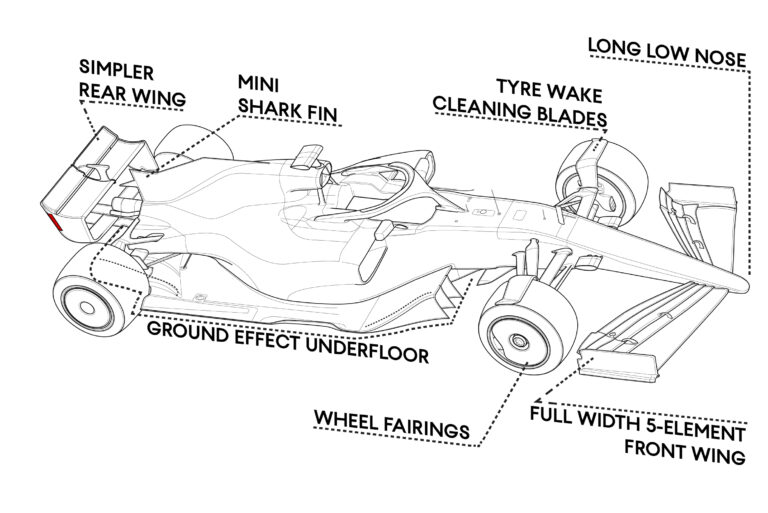Formula 1 is an adrenaline-pumping motorsport where top drivers compete in technologically advanced cars at incredible speeds. This exhilarating sport combines strategy, skill, and speed, making each race thrilling and unpredictable.
With technology and safety protocols continuously evolving, every season presents new challenges and regulations. Dive into the technical aspects of Formula 1 racing in this comprehensive guide and learn more about the ins and outs of F1 racing.
General Principles
In Formula 1, all participants—including the FIA, teams, organizers, drivers, and circuits—must follow the sport’s rules and hold an FIA Super License.
Stewards can ban cars with potentially dangerous designs. New technology must be FIA-approved and can only be used for the current championship. Teams must demonstrate compliance with all regulations to FIA technical delegates and stewards during competition.
Aerodynamic Components
Aerodynamic components(often called Aero parts) are car parts that interact with the external air stream. These components must be securely attached and produce a smooth surface. The vehicle’s bodywork must be symmetrical, meaning both sides must be identical. Devices that bridge the gap between the car and the ground are not allowed.
To enfore this, the FIA requires teams to provide CAD models to verify compliance with regulations, which may also be physically measured during competitions.
Car Weight Regulations
The car’s weight, without fuel, must exceed 796 kg and can include ballast, as long as it is attached and immobile. The driver and ballast designated for this purpose must weigh no less than 80kg during competition.
No substances can be added to the car during competition, and replacement parts must be equal to the original ones. If necessary, an FIA technical delegate may weigh the car using dry-weather tires.
Power Units and Engines
The “Power Unit” in F1 racing consists of the internal combustion engine, turbocharger, and related systems, including energy recovery and control electronics. Only four-stroke, six-cylinder engines are allowed. These engines must have DC sensors to verify energy and power requirements, which must be manufactured and calibrated by FIA-designated suppliers and cannot be installed within the sealed perimeter of the power unit. The power unit’s mass must be at least 151 kg.
Fuel, Oil, and Cooling Systems
Fuel tanks must be a single rubber bladder that meets FIA Standard FT5-1999 specifications and cannot be used five years after its date of manufacture. They must be equipped with a pressure relief valve, fuel tank pressure sensor, and self-sealing breakaway valve. No coolant or oil lines can pass through the cockpit. Only ambient air is allowed to mix with fuel as an oxidant, and fuel must have prior written approval from the FIA.
Electrical Systems
An electrical system refers to any command system or process that uses semiconductor or thermionic technology. Teams must register all on-car software versions with the FIA. The FIA Standard ECU must control components of the power unit, fuel system, transmission system, brake system, and others. The FIA must homologate the ECUs, control sensors, actuators, and FIA monitoring sensors. Data acquisition systems must be physically separate and electrically isolated from control electronics.
Transmission
In Formula 1 racing, the transmission is only rear drive. There can’t be any system to prevent the driven wheels from spinning or compensating for excessive torque. Clutch operation should be through paddles, and holding positions are not allowed.
When the engine is stopped, the car must be able to disengage the clutch for at least 15 minutes.
The combined mass of the driveline and gear-change components must be no less than 22 kg.
Brakes, Suspension, Steering, Wheels, and Tires
F1 cars must have sprung suspensions and independent suspension for each axle. They cannot use any powered device to change the suspension configuration. Power-assisted steering cannot be electronically controlled.
Cars must have a single brake system with one pedal and two master cylinders, each operating two wheels: one for the front wheels and one for the rear wheels. All brake calipers must be made from aluminum materials.
Car Construction and Survival Cell
The design of the survival cell and bodywork must allow easy access to the cockpit, and the shape of the survival cell shouldn’t be visible from the sides. The space around the driver’s head must not exceed 550mm, and no head support can be less than 25mm from any structural part of the car. To protect the driver in case of an inverted crash, the car must have two roll structures.
Safety Structures, Equipment, and Homologation
The FIA has the right to modify safety regulations if a weakness is discovered and must be informed of any changes. A 50mm aluminum plate must be attached to the front bulkhead of the survival cell. The car must have two impact-absorbing structures on each side of the survival cell and one in front and behind the gearbox. All structures must be solid and symmetrically attached to the survival cell. Additionally, all cars must have a fire extinguishing system.





